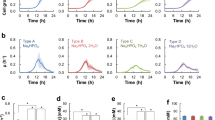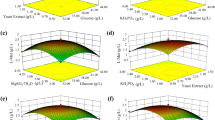Abstract
In the biotechnology sector, a main processing goal is the production of high cell (and hence product) yields. Therefore, little consideration is traditionally given to the potential environmental impacts of excess culture media ingredients. This study investigated the scope for reducing the quantities of phosphorus (P) present in both a complex terrific broth (TB) and semi-defined minimal media 9/yeast extract (M9/YE) fermentation media used to culture a model Escherichia coli strain engineered to produce a recombinant β-galactosidase. Reductions of up to 70 % did not adversely affect biomass yields attained; however, further P minimization leads to a drop in dry cell weight obtained, particularly in the case of semi-defined media. P concentration in TB media had little effect upon total recombinant protein expression levels achieved. In the case of M9/YE media, reductions >70 % P negatively affected product expression levels. Protein functionality, assessed by k m and V max, was not influenced by the type of media nor the P concentration present. Overall, the results indicate that P can be reduced by a minimum of 70 % without adversely affecting the biomass yield, the recombinant protein yield or functionality. Such reductions should lead to significant P savings in the large-scale manufacturing of proteins produced by genetic engineering in E. coli.


Similar content being viewed by others
References
APHA (1995) Standard Methods for the examination of water and wastewater, 19th edn. American Health Association, Washington
Aristidou AA, San K-Y, Bennett GN (1999) Improvement of biomass yield and recombinant gene expression in Escherichia coli by using fructose as the primary carbon source. Biotechnol Prog 15(1):140–145
Atlas RM (2004) Handbook of microbiological media, 3rd edn. CRC Press, Boca Raton
Behme S (2009) Manufacturing of pharmaceutical protein: from technology to economy. Wiley, Weinheim
Cappucino JG, Sherman N (2005) Microbiology: a laboratory manual, 7th edn. Benjamin Cummings, San Franscisco
Choi JH, Keum KC, Lee SY (2006) Production of recombinant proteins by high cell density culture of Escherichia coli. Chem Eng Sci 61(3):876–885
Cliffe FE, Walsh G, O’Dwyer TF (2010) Utilisation of phosphorus nutrient content in industrial scale plasmid DNA production: a waste minimisation study. J Clean Prod 18(10–11):1066–1072. doi:10.1016/j.jclepro.2010.02.013
Crespo AL, Spencer TA, Nekl E, Pusztai-Carey M, Moar WJ, Sigfried BD (2008) Comparison and Validation of methods to quantify Cry1Ab toxin from Bacillus thuringiensis for standardization of insect bioassays. Appl Environ Microbiol 74(1):130–135
Demain AL, Vaishnav P (2009) Production of recombinant proteins by microbes and higher organisms. Biotechnol Adv 27(3):297–306
Eiteman MA, Altman E (2006) Overcoming acetate in Escherichia coli recombinant protein fermentations. Trends Biotechnol 24(11):530–536
Fowler AV, Zabin I (1977) The amino acid sequence of β-galactosidase of Escherichia coli. Proc Natl Acad Sci USA 74(4):1507–1510
Ho SV (2010) Environmental considerations in biologics manufacturing. In: Dunn PJ, Wells AS, Williams MT (eds) Green chemistry in the pharmaceutical industry. Wiley, Weinhaim, pp 311–331
Jacobson RH, Zhang XJ, DuBose RF, Matthews BW (1994) Three-dimensional structure of β-galactosidase from E. coli. Nature 369(6483):761–766
Juers DH, Jacobson RH, Wigley D, Zhang XJ, Huber RE, Tronrud DE, Matthews BW (2000) High resolution refinement of β-galactosidase in a new crystal form reveals multiple metal-binding sites and provides a structural basis for alpha-complementation. Prot Sci 9(9):1685–1699
Khan FA, Ansari AA (2005) Eutrophication: an ecological vision. Bot Rev 71(4):449–482
Kosinski MJ, Bailey JE (1991) Temperature and induction effects on the degradation rate of an abnormal β-galactosidase in Escherichia coli. J Biotechnol 18(1–2):55–68
Krause M, Ukkonen K, Haataja T, Ruottinen M, Glumoff T, Neubauer A, Neubauer P, Vasala A (2010) A novel fed-batch based cultivation method provides high cell-density and improves yield of soluble recombinant proteins in shaken cultures. Microb Cell Fact 9(1):11–22
Li X, Robbins JW Jr, Taylor KB (1990) The production of recombinant beta-galactosidase in Escherichia coli in yeast extract enriched medium. J Ind Microbiol 5(2–3):85–93. doi:10.1007/bf01573857
Luli GW, Strohl WR (1990) Comparison of growth, acetate production, and acetate inhibition of Escherichia coli strains in batch and fed-batch fermentations. Appl Environ Microbiol 56(4):1004–1011
Matthews BW (2005) The structure of E. coli β-galactosidase. CR Biol 328(6):549–556
Miller T, Churchill BW (1986) Substrates for large-scale fermentations. In: Demain AL, Solomon NA (eds) Manual of industrial microbiology and biotechnology. ASM Press, Washington, pp 122–136
Nichols E, Gavina J, McLeod R, Craig D (2007) Single molecule assays of β-galactosidase from two wild-type strains of E. coli: effects of protease inhibitors on microheterogeneity and different relative activities with differing substrates. Protein J 26(2):95–105. doi:10.1007/s10930-006-9050-3
O’Connell S, Walsh G (2007) Purification and properties of a β-galactosidase with potential application as a digestive supplement. Appl Biochem Biotechnol 141(1):1–13
Ransohoff TC (2011) Global trends in mammalian cell culture capacity and biomanufacturing. In: Paper presented at the Swiss Biotech Program at BioPharm America 2011 Boston, MA, Sept 2011
Sambrook J, Russell DW (2001) Molecular cloning: a laboratory manual, 3rd edn. Cold Spring Harbor Laboratory Press, New York
Steers E Jr, Cuatrecasas P, Pollard HB (1971) The purification of β-galactosidase from Escherichia coli by affinity chromatography. J Biol Chem 246(1):196–200
Suárez DC, Liria CW, Kilikian BV (1998) Effect of yeast extract on Escherichia coli growth and acetic acid production. World J Microbiol Biotechnol 14(3):331–335. doi:10.1023/a:1008800908696
Tripathi NK, Sathyaseelan K, Jana AM, Rao PVL (2009) High yield production of heterologous proteins with Escherichia coli. Def Sci J 59(2):137–146
Wilkinson DL, Harrison RG (1991) Predicting the solubility of recombinant proteins in Escherichia coli. Nat Biotechnol 9(5):443–448
Zhang J, Greasham R (1999) Chemically defined media for commercial fermentations. Appl Microbiol Biotechnol 51(4):407–421
Acknowledgments
This project is funded as part of the Science, Technology, Research and Innovation for the Environment (STRIVE) Programme 2007–2013. The programme is financed by the Irish Government under the National Development Plan 2007–2013 (Grant number 2008-S-ET-1), and it is administered on behalf of the DEHLG by the Environmental Protection Agency (EPA) which has the statutory function of coordinating and promoting environmental research.
Author information
Authors and Affiliations
Corresponding author
Rights and permissions
About this article
Cite this article
Witt, M.K., O’Dwyer, T.F. & Walsh, G. Minimization of phosphorus in the fermentation media of Escherichia coli producing a model recombinant protein. Int. J. Environ. Sci. Technol. 12, 2035–2042 (2015). https://doi.org/10.1007/s13762-014-0604-1
Received:
Revised:
Accepted:
Published:
Issue Date:
DOI: https://doi.org/10.1007/s13762-014-0604-1




